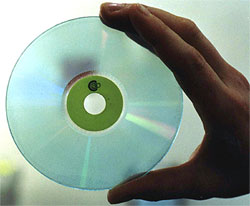 As the CD is
read from the bottom by a tiny reading laser, the light shines up
through the transparent polycarbonate and strikes the metal layer where it is reflected.
If the laser shines onto one
of the flat portions of the disk (the 'lands') it will be
reflected almost straight back and read by the optical sensor of the CD-drive.
As the CD is
read from the bottom by a tiny reading laser, the light shines up
through the transparent polycarbonate and strikes the metal layer where it is reflected.
If the laser shines onto one
of the flat portions of the disk (the 'lands') it will be
reflected almost straight back and read by the optical sensor of the CD-drive.
If the
laser shines onto one of the molded bumps, which as the CD is read from the
bottom, appear as 'pits,' it will be reflected at an angle and not picked up by
the sensor. By precisely timing the speed at which the laser moves over the
surface of the CD, and calculating positive reflections as values of '1'
and non-reflections as values of '0,' digital data can be read from a CD.
CD-R disks, or recordable
CDs, work in a similar fashion, with one major exception. As they are blank
until imprinted with data, they are not 'stamped' or injection molded at
the factory. Rather, a thin layer of dye is added between
the polycarbonate and the reflective metal layer.
This dye is completely clear until the more powerful
writing laser of a CD-R drive is used to darken it, covering the reflective
metal underneath. By selectively darkening minute sections of this dye layer, a
reflective/non-reflective pattern is created which can be read in exactly the
same fashion as a conventional 'stamped' CD.
CD-RW
disks, or rewritable CDs, use yet another system. In place of the dye layer used by recordable
CDs, they use a special compound which reacts to the various levels of heat
provided by the 'write' or 'erase' lasers of a CD-RW drive. When activated the dye becomes
crystalline and transparent/melted (its default state) or amorphous and non-reflective (when
heated by the 'write' laser).
The melted, non-crystalline
areas signify a binary '0' while the crystalline, transparent areas allow the
read laser to reflect off the metal underneath and signify a binary '1.' Unlike
recordable CDs, whose dye layer cannot be reused once it has been written to,
passing a laser over the CD-RW surface at a certain intensity will cause the
melted compound to retake its crystalline form and regain its transparency,
effectively erasing all the data on the disk.
Commercial DVDs
are formed using a similar process to 'stamped' CDs, except that multiple thin layers of polycarbonate are molded,
one for each data 'layer' of the disk. A DVD can have up
to two layers on each side of the disk, for a total of four. The
reading of multiple tracks on a single side is enabled by using a semi-transparent
gold film as the reflective material for the first layer of data on a
two-layer DVD, and a fully reflective aluminum coating for the second.
In this way, the reading
laser can be modulated to pass through or reflect from the gold layer, depending
on whether data from the first or second layer is desired.
Otherwise, DVD data is stored
using bumps and 'lands' to represent digital information, the same as CDs. The
tracks of data on a DVD are considerably smaller and tighter packed than on a CD
however, enabling DVD's considerably higher data capacity.
Writeable DVD disks use a variety of techniques which we
will detail below when we discuss the various formats currently on the
market.

